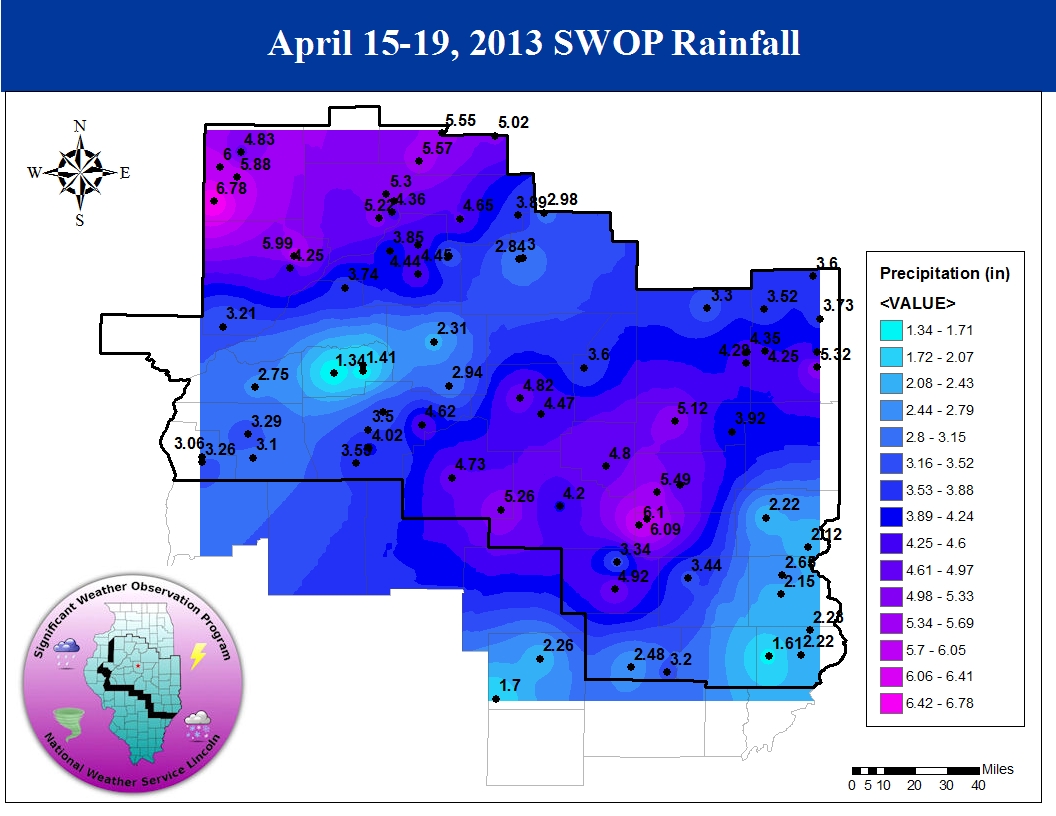April 15-19, 2013
A slow-moving storm system dumped copious amounts of rain across central and southeast Illinois during the week of April 15th through 19th. Rainfall totals between 5 and 7 inches occurred along and west of the Illinois River, as well as further east along a Paris...to Mattoon...to Shelbyville line. Most of the rain fell in a relatively short period of time from Wednesday, April 17th through Thursday, April 18th. Due to already very wet soil conditions, the excessive rainfall led to widespread flooding of many rural and low-lying areas. In addition, nearly every river across the area exceeded flood stage.
After a late winter and early spring marked by unseasonably cool weather, the pattern made a drastic change on April 15th. The upper-level trough of low pressure that had previously plagued the Great Lakes and Upper Midwest temporarily shifted to the northeast and was replaced by a strong ridge of high pressure across the southeast U.S. This provided a deep-layer southwesterly flow from the Southern Plains to the Great Lakes. Not only did this allow temperatures to climb above normal into the 70s, but it also helped transport large amounts of moisture northward into the area. Upper-air soundings conducted by NWS Lincoln showed precipitable water values rising to around 1.50 inches by Thursday morning. Precipitable water is a measure of the total amount of water contained within the entire depth of the atmosphere, and the 1.50 amount was in the 99th percentile for April 18th. This shows that an unseasonably high amount of moisture was contained within the airmass.
A cold front slowly pushed eastward into this increasingly moist airmass by Wednesday, April 17th...however, the boundary gradually became parallel to the southwesterly upper flow and could no longer move eastward. As a result, the front stalled near the Mississippi River. Showers and thunderstorms developed along and ahead of the stationary boundary and repeatedly trained along the same locations Wednesday afternoon and night. Many areas along and west of the Illinois River experienced nearly non-stop rain and thunder for several hours on Wednesday, with rainfall amounts reaching the 2 to 4-inch range. The showers and storms finally got a push eastward Thursday morning: however, they weakened considerably as they approached the I-55 corridor.
Showers and thunderstorms re-generated further southeast along and ahead of an outflow boundary on Thursday, April 18th. Once again, thunderstorms tracked from southwest to northeast parallel to the upper-level flow...with cells repeatedly training over the same locations from Shelbyville northeastward to Danville and Paris. Torrential rainfall of 3 to 5 inches fell across this area, resulting in flooding of low-lying areas and rivers across east-central Illinois.
An approaching upper-level trough finally gave the cold front a solid push out of the area by Thursday evening, allowing the persistent rains to gradually taper off and came to an end as a cooler and drier airmass moved in from the northwest. Rainfall from this event was quite impressive...with daily rain records being established at many sites. Peoria set 24-hour rainfall records on Wednesday, April 17th with 2.47 and on Thursday, April 18th with 1.37. Galesburg set a daily record of a whopping 4.16 on Thursday, April 18th.
Even though the rain has long since ended, its effects will continue to be felt for quite some time. Nearly every river across central and southeast Illinois exceeded flood stage in the wake of this system, with some rivers reaching major flood stage. Most creeks and streams will begin to recede over the next few days: however, the larger rivers such as the Illinois and Sangamon will continue to rise as water works its way through the system. All-time record crests are anticipated along the Illinois River next week.
